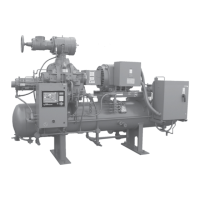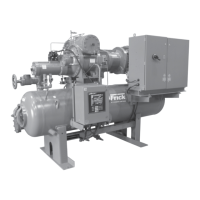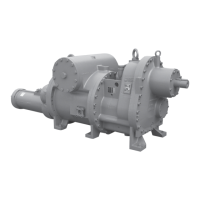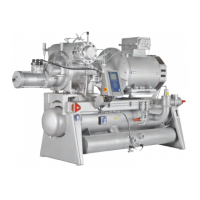RWB II ROTARY SCREW COMPRESSOR UNITS
MAINTENANCE
070.200-IOM (DEC 11)
Page 30
oil. Check for roughness by turning outer race by hand and
replace bearings if they have roughness.
Be sure shaft is free from nicks, burrs and foreign particles
that might damage mechanical seal. Scratches on shaft in
seal area will provide leakage paths under mechanical seal.
Use fine emery cloth to remove scratches or sharp edges.
DEMAND PUMP ASSEMBLY
Assembly Notes On Standard Mechanical Seal (Synthetic
Rubber Bellows Type)
NOTE: Read carefully before reassembling pump
The seal used in this pump is simple to install and good
performance will result if care is taken during installation.
The principle of mechanical seal is contact between the
rotary and stationary members. These parts are lapped to
a high finish and their sealing effectiveness depends on
complete contact.
Prior to installing rotary portion of mechanical seal, prepare
and organize rotor shaft, head and idler assemblies and ap‑
propriate gaskets for quick assembly
Once rotary portion of mechanical seal is installed on rotor
shaft, it is necessary to assemble parts as quickly as pos‑
sible to ensure that the seal does not stick to shaft in wrong
axial position. The seal will stick to the shaft after several
minutes setting time.
Never touch sealing faces with anything except clean hands
or clean cloth. Minute particles can scratch the seal faces
and cause leakage.
1. Coat idler pin with refrigeration oil and place idler and
bushing on idler pin in head. If replacing a carbon‑graphite
bushing, refer to "Installation of Carbon Graphite Bushings".
2. Clean rotor hub and casing seal housing bore. Make sure
both are free from dirt and grit. Coat outer diameter of seal
seat and inner diameter of seal housing bore with refrigera‑
tion oil.
3. Start seal seat in seal housing bore. If force is necessary,
protect seal face with a clean cardboard disc and gently tap it
in place with a piece of wood. Be sure seal seat is completely
seated in the bore.
4. Place tapered installation sleeve on shaft. Refer to Figure
28. Sleeve is furnished with GG, AS, AK, and AL replace‑
ment mechanical seals. Coat rotor shaft, tapered installation
Figure 28
sleeve, and inner diameter of mechanical seal rotary mem ber
with a generous amount of refrigeration oil. Petrolatum may
be used but grease is not recommended.
5. Place seal spring on shaft against rotor hub. Refer to
Figure 28.
6. Slide rotary member, with lapped contact surface facing
away from spring, over installation sleeve on shaft until just
con tacting the spring. Do not compress spring. Remove
installa tion sleeve.
7. Coat rotor shaft with refrigeration oil. Install shaft slowly
pushing until the ends of rotor teeth are just below the face
of the casing.
8. Leave the rotor in this position. Withdrawal of rotor and
shaft may displace the carbon seal rotating face and result
in damage to the seal.
9. Place O‑ring gasket on head and install head and idler
assembly on pump. Pump head and casing were marked
before disassembly to ensure proper reassembly. If not, be
sure idler pin, which is offset in pump head, is positioned up
and equal distance between port connections to allow for
proper flow of liquid through pump.
10. Tighten head capscrews evenly
11. Pack inner ball bearing with multipurpose grease,
NLGI #2.
GG, HJ, HL: Install bearing in casing with sealed side towards
head end of pump. Drive the bearing into the bore. Tap the
inner race with a brass bar and lead hammer to position
bearing. Install inner snap ring.
AS, AK, AL: Install bearing retainer washer over the shaft
before installing ball bearing. Install ball bear ing in casing with
sealed side towards head end of pump. Drive the bearing
into the bore. Tap the inner race with a brass bar and lead
hammer to position bearing.
12. GG, HJ, HL: Install shaft snap ring in groove in the shaft.
See Figure 25.
AS, AK, AL: Install bearing spacer over shaft and against
single row ball bearing. See Figure 26.
13. Pack lubrication chamber between inner ball bearing
and double‑row ball bearing in the thrust‑bearing assembly
approximately one‑half full of multipurpose grease, NLGI #2.
The thrust‑bearing assembly will take the remaining space.
See Figure 25 and 26.
Figure 27

